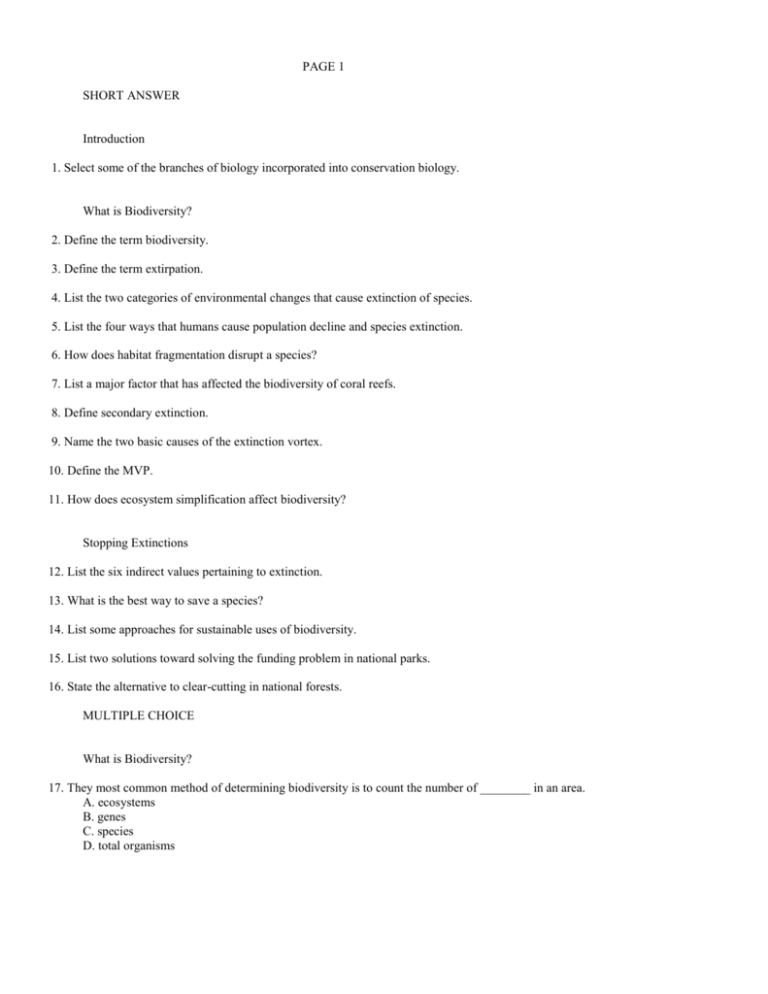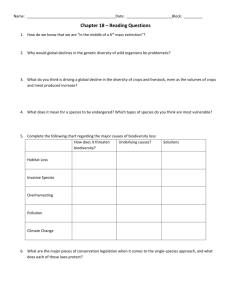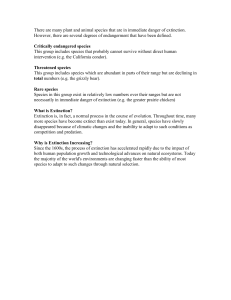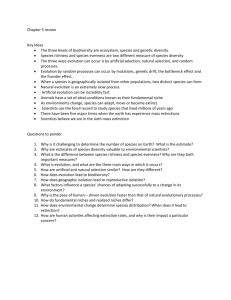
PAGE 1
SHORT ANSWER
Introduction
1. Select some of the branches of biology incorporated into conservation biology.
What is Biodiversity?
2. Define the term biodiversity.
3. Define the term extirpation.
4. List the two categories of environmental changes that cause extinction of species.
5. List the four ways that humans cause population decline and species extinction.
6. How does habitat fragmentation disrupt a species?
7. List a major factor that has affected the biodiversity of coral reefs.
8. Define secondary extinction.
9. Name the two basic causes of the extinction vortex.
10. Define the MVP.
11. How does ecosystem simplification affect biodiversity?
Stopping Extinctions
12. List the six indirect values pertaining to extinction.
13. What is the best way to save a species?
14. List some approaches for sustainable uses of biodiversity.
15. List two solutions toward solving the funding problem in national parks.
16. State the alternative to clear-cutting in national forests.
MULTIPLE CHOICE
What is Biodiversity?
17. They most common method of determining biodiversity is to count the number of ________ in an area.
A. ecosystems
B. genes
C. species
D. total organisms
PAGE 2
18. Taxonomists mainly
A. carry out genetic crosses
B. classify organisms
C. study cells through the microscope
D. test the effectiveness of various drugs
19. The largest number of species on the Earth are
A. birds
B. insects
C. plants
D. vertebrates
20. Most scientists live in
A. Asia
B. Canada
C. Mexico and South America
D. North America and Europe
21. The most species are found in the ________ regions.
A. arctic
B. temperate
C. tropic
D. subtropic
22. The oceans cover about ________ % of the surface of the Earth.
A. 25
B. 50
C. 70
D. 90
23. In Europe there are about ________ fungus species for each plant species.
A. 2
B. 6
C. 10
D. 20
24. On the species-area curve as the number of species counted increases the curve
A. does not change
B. flattens out
C. slopes downward
D. slopes upward
25. Areas of the tropical rain forests have over ________ times the number of species found in temperate regions.
A. 100
B. 1000
C. 10000
D. 100000
26. One valid estimate of the species number on the Earth is
A. 1 million to 4 million
B. 5 million to 100 million
C. 500 million to 700 million
D. 800 million to 1 billion
PAGE 3
27. Ecological extinction means that the species is
A. completely extinct
B. rare but still having an ecological impact
C. rare to the point it has no ecological impact
D. recovering its numbers in an area
28. Select the incorrect statement.
A. Bird and mammal extinction rates have been underestimated.
B. Birds and mammals are well-described groups.
C. The extinction of birds has been increasing rapidly.
D. The extinction of mammals has not been increasing rapidly.
29. Select the class with the largest number of species.
A. amphibians
B. birds
C. fish
D. mammals
30. Select the class with the smallest number of species from the following choices.
A. amphibians
B. birds
C. fish
D. reptiles
31. The rainforests contain about ________ % of the species of the world.
A. 10
B. 30
C. 50
D. 90
32. The rainforests cover about ________ % of the surface of the Earth.
A. 7
B. 15
C. 25
D. 38
33. The edge effect has particularly affected ________ populations.
A. fish
B. human
C. invertebrate
D. songbird
34. An exotic species for an area is a(n. ________ species.
A. endangered
B. extinct
C. established
D. new
35. Threatened coral reefs have occurred at noticeable frequency at each of the following coastlines except
A. eastern Africa
B. eastern Asia
C. northern Australia
D. western North America
PAGE 4
36. What fish species has caused the extinction of over 35 species of fish in Lake Victoria?
A. Nigerian bass
B. Nigerian perch
C. Nile bass
D. Nile perch
37. Most analysts agree that the MVP of a population must be at least a few
A. dozen
B. hundred
C. thousand
D. million
38. Indicator species reveal the ________ of an ecosystem.
A. diversity
B. health
C. location
D. size
39. A keystone species in a community is one that
A. is largest in body size
B. occurs in greatest abundance
C. other species depend on
D. will always be the most likely for extinction
Stopping Extinctions
40. Select the intrinsic value among the indirect values for extinction.
A. economic
B. emotional
C. ethical
D. evolutionary
41. What is the raw material for evolution?
A. artificial selection
B. genetic stability
C. mutation
D. natural selection
42. The terms species triage refer to
A. ecological fitness
B. extinction rates
C. the abundance of species
D. which species to save
43. In 1994 about ________ % of the crayfish and freshwater species were at risk.
A. 10
B. 30
C. 50
D. 90
44. A unique species is
A. closely related to other living species
B. not closely related to other living species
C. related to other carnivores
D. related to other herbivores
PAGE 5
45. Charismatic species
A. attract public support
B. have many detractors
C. have wide geographic ranges
D. lack predators
46. Umbrella species
A. hide other species
B. kill other species
C. lack any relationship to other species
D. protect other species
47. Ecologically, hot spots in habitats have high
A. altitudes
B. geographical range
C. species richness
D. temperatures
48. Each of the following describes buffer zones except
A. campgrounds are an example
B. human disturbance occurs
C. moderately utilized land
D. transition zones
49. Select the hot spot for amphibians.
A. Sierra Nevada
B. southeastern Coastal Plain
C. southern Appalachians
D. western Great Plains
50. Select the well-known state that is a hotspot for vascular plants.
A. Alaska
B. California
C. Pennsylvania
D. Utah
51. The National Park System includes _______ national parks.
A. 10
B. 50
C. 100
D. 200
52. About ________ % of the commercial forest area in the United States is in national forests.
A. 8
B. 22
C. 40
D. 60
53. Overall about ________ % of the land of the world is protected.
A. 1
B. 6
C. 11
D. 20
PAGE 6
54. The goal of chemical prospecting is to compile the
A. chemical hazards to various species
B. chemical potential of various species
C. rates of cycling of minerals through ecosystems
D. rates of loss of nutrients to species
55. Compared to breeding in the wild, breeding in captivity is
A. less effective and less expensive
B. less effective and more expensive
C. more effective and less expensive
D. more expensive and more effective
56. The National Parks in the United States are
A. overcrowded and overfunded
B. overcrowded and underfunded
C. undercrowded and overfunded
D. undercrowded and underfunded
TRUE-FALSE
What is Biodiversity?
57. Regions with low diversity often have fewer species at the local level.
58. Vertebrates are studied more than animals without a backbone.
59. Most biologists state that fewer species live on the land than in the oceans.
60. The number of families of organisms in the oceans has increased through time.
61. The terms biological impoverishment mean that there is a loss of variety in the biosphere.
62. Biological impoverishment is much more common on the Earth than ecological extinction.
63. There are more species of invertebrates than species of vertebrates.
64. There are more species of flowering plants than species of invertebrates.
65. According to some studies, a loss of 90% habitat eliminates 50% of the species.
66. In most cases species extinction occurs from one cause.
67. Coral reefs generally have low biodiversity.
68. Exotic species often have a relatively easy time becoming established on new islands.
69. Most species are rare in nature.
70. In monocultures stability is low.
PAGE 7
Stopping Extinctions
71. Species with limited habitats are less vulnerable to extinction.
72. Species with large territories are more likely to be extinct.
73. Predators are generally high on the food pyramid.
74. Large predators often control the population dynamics of herbivores.
75. Larger size increases the number of species in a preserve.
76. In a natural habitat that is not designated as wilderness the multiple-use principle is common.
77. Fragmentation of land often reduces biodiversity.
78. Most species at risk are on federal land rather than on privately owned land.
79. Money funded by the Endangered Species Act has been evenly distributed over trying to protect many different species.
80. More attention has been given in recent years to the extinction of ocean species compared to land species.
(c) 1998 by Jones & Bartlett Publishers. All rights reserved
PAGE 1
ANSWER KEY FOR TEST - UNTITLED
1. genetics, ecology
Chapter:12
QUESTION: 1
(p. )
2. It is the variety and variability among living organisms and the ecological complexes in which they occur.
Chapter:12
QUESTION: 2
(p. )
3. It means that the species has died out in a local area.
Chapter:12
QUESTION: 17
(p. )
4. changes in the physical environment and changes in the biological environment
Chapter:12
QUESTION: 27
(p. )
5. habitat disruption, introduction of new species, overhunting, and secondary extinctions
Chapter:12
QUESTION: 29
(p. )
6. It separates populations into local groups, preventing them from reproducing.
Chapter:12
QUESTION: 32
(p. )
7. sedimentation
Chapter:12
QUESTION: 35
(p. )
8. It is when the extinction of one group causes the extinction of another.
Chapter:12
QUESTION: 41
(p. )
9. Small populations have breeding problems and small populations are easily wiped out by random environmental fluctuations.
Chapter:12
QUESTION: 42
(p. )
10. It is the smallest population needed to stay above the extinction vortex.
Chapter:12
QUESTION: 43
(p. )
11. The number of species declines.
Chapter:12
(p. )
QUESTION: 45
12. ethical, esthetics, emotional, economic, environmental services, evolutionary
Chapter:12
QUESTION: 49
(p. )
13. The best way is to protect the environment of the species.
Chapter:12
QUESTION: 61
(p. )
PAGE 2
14. bottom-up approach, ecotourism, sustainable harvesting
Chapter:12
QUESTION: 74
(p. )
15. make them more self-sufficient and remove some of the less popular ones from operation
Chapter:12
QUESTION: 79
(p. )
16. selective cutting
Chapter:12
QUESTION: 80
Chapter:12
QUESTION: 3
Chapter:12
QUESTION: 5
Chapter:12
QUESTION: 6
Chapter:12
QUESTION: 8
Chapter:12
QUESTION: 9
Chapter:12
QUESTION: 10
Chapter:12
QUESTION: 11
Chapter:12
QUESTION: 12
Chapter:12
QUESTION: 13
Chapter:12
QUESTION: 14
Chapter:12
QUESTION: 18
(p. )
17. C
(p. )
18. B
(p. )
19. B
(p. )
20. D
(p. )
21. C
(p. )
22. C
(p. )
23. B
(p. )
24. B
(p. )
25. A
(p. )
26. B
(p. )
27. C
(p. )
PAGE 3
28. D
Chapter:12
QUESTION: 21
Chapter:12
QUESTION: 22
Chapter:12
QUESTION: 23
Chapter:12
QUESTION: 30
Chapter:12
QUESTION: 31
Chapter:12
QUESTION: 33
Chapter:12
QUESTION: 36
Chapter:12
QUESTION: 37
Chapter:12
QUESTION: 39
Chapter:12
QUESTION: 44
Chapter:12
QUESTION: 46
Chapter:12
QUESTION: 48
Chapter:12
QUESTION: 50
Chapter:12
QUESTION: 51
(p. )
29. C
(p. )
30. A
(p. )
31. C
(p. )
32. A
(p. )
33. D
(p. )
34. D
(p. )
35. D
(p. )
36. D
(p. )
37. C
(p. )
38. A
(p. )
39. C
(p. )
40. C
(p. )
41. C
(p. )
PAGE 4
42. D
Chapter:12
QUESTION: 52
Chapter:12
QUESTION: 56
Chapter:12
QUESTION: 58
Chapter:12
QUESTION: 59
Chapter:12
QUESTION: 60
Chapter:12
QUESTION: 62
Chapter:12
QUESTION: 64
Chapter:12
QUESTION: 65
Chapter:12
QUESTION: 66
Chapter:12
QUESTION: 67
Chapter:12
QUESTION: 70
Chapter:12
QUESTION: 73
Chapter:12
QUESTION: 75
Chapter:12
QUESTION: 77
(p. )
43. C
(p. )
44. B
(p. )
45. A
(p. )
46. D
(p. )
47. C
(p. )
48. B
(p. )
49. C
(p. )
50. B
(p. )
51. B
(p. )
52. B
(p. )
53. B
(p. )
54. B
(p. )
55. B
(p. )
PAGE 5
56. B
Chapter:12
QUESTION: 78
Chapter:12
QUESTION: 4
Chapter:12
QUESTION: 7
Chapter:12
QUESTION: 15
Chapter:12
QUESTION: 16
Chapter:12
QUESTION: 19
Chapter:12
QUESTION: 20
Chapter:12
QUESTION: 24
Chapter:12
QUESTION: 25
Chapter:12
QUESTION: 26
Chapter:12
QUESTION: 28
Chapter:12
QUESTION: 34
Chapter:12
QUESTION: 38
Chapter:12
QUESTION: 40
(p. )
57. True
(p. )
58. True
(p. )
59. False
(p. )
60. True
(p. )
61. True
(p. )
62. True
(p. )
63. True
(p. )
64. False
(p. )
65. True
(p. )
66. False
(p. )
67. False
(p. )
68. True
(p. )
69. True
(p. )
PAGE 6
70. True
Chapter:12
QUESTION: 47
Chapter:12
QUESTION: 53
Chapter:12
QUESTION: 54
Chapter:12
QUESTION: 55
Chapter:12
QUESTION: 57
Chapter:12
QUESTION: 63
Chapter:12
QUESTION: 68
Chapter:12
QUESTION: 69
Chapter:12
QUESTION: 71
Chapter:12
QUESTION: 72
Chapter:12
QUESTION: 76
(p. )
71. False
(p. )
72. True
(p. )
73. True
(p. )
74. True
(p. )
75. True
(p. )
76. True
(p. )
77. True
(p. )
78. False
(p. )
79. False
(p. )
80. False
(p. )
(c) 1998 by Jones & Bartlett Publishers. All rights reserved
PAGE 1
ANSWER SHEET FOR TEST - UNTITLED
1) ___________
2) ___________
3) ___________
4) ___________
5) ___________
6) ___________
7) ___________
8) ___________
9) ___________
10) ___________
11) ___________
12) ___________
13) ___________
14) ___________
15) ___________
16) ___________
17) ___________
18) ___________
19) ___________
20) ___________
21) ___________
22) ___________
23) ___________
24) ___________
25) ___________
26) ___________
27) ___________
28) ___________
PAGE 2
29) ___________
30) ___________
31) ___________
32) ___________
33) ___________
34) ___________
35) ___________
36) ___________
37) ___________
38) ___________
39) ___________
40) ___________
41) ___________
42) ___________
43) ___________
44) ___________
45) ___________
46) ___________
47) ___________
48) ___________
49) ___________
50) ___________
51) ___________
52) ___________
53) ___________
54) ___________
55) ___________
56) ___________
57) ___________
PAGE 3
58) ___________
59) ___________
60) ___________
61) ___________
62) ___________
63) ___________
64) ___________
65) ___________
66) ___________
67) ___________
68) ___________
69) ___________
70) ___________
71) ___________
72) ___________
73) ___________
74) ___________
75) ___________
76) ___________
77) ___________
78) ___________
79) ___________
80) ___________
(c) 1998 by Jones & Bartlett Publishers. All rights reserved










